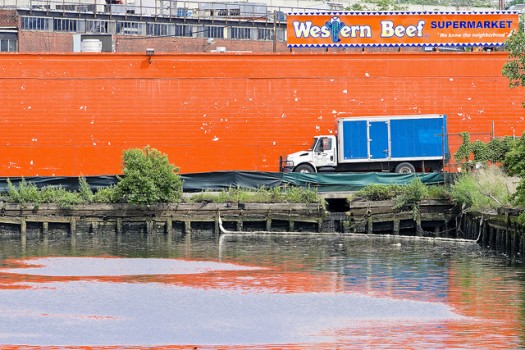
We are celebrating 15 years — and counting — of stories that are deeply researched and deeply felt, that build a historical record of what the city has been.
We are celebrating 15 years — and counting — of stories that are deeply researched and deeply felt, that build a historical record of what the city has been.
CUTTING RED TAPE
Deputy Mayor Robert Steel announced two separate initiatives this week that will expedite municipal processes for development and encourage locally managed service delivery. The first, called BluePRint (for Business Process Reform), streamlines the land-use application and review process that, under the current system, can take years to complete. BluePRint “is expected to allow City Planning to review two-thirds of all applications 25% to 50% faster than it does today… [and] is expected to save developers up to $100 million annually in various costs.” The second initiative aims to make it easier and less costly for small commercial centers to form Business Improvement Districts (BIDs) and to encourage existing BIDs to compete for grants (of up to $75,000) for innovative ideas that spur job creation and investment. 23 of the 67 existing BIDs in New York were created during Mayor Bloomberg’s tenure, reflecting this administration’s enthusiasm for this kind of public-private partnership: local property and business owners getting together and assessing fees to support services and investment, such as supplemental trash collection, public safety and visitor services, as well as marketing and beautification projects for the area. Read more about both initiatives in Crain’s Real Estate section.
EXPANDING BROADBAND
Also out of City Hall this week is an announcement of five new initiatives to improve and expand high-speed broadband access. As New York City looks to its growing tech scene for economic growth and proof of its competitiveness, patchy connectivity, inadequate infrastructure in “digital deserts” (underserved areas, such as industrial neighborhoods) and lack of access in low-income communities challenge the city’s claim to being the next “tech capital of the world.” To address these problems, Mayor Bloomberg, the NYC Economic Development Corporation and the Department of Information Technology and Telecommunications are rolling out a few new strategies. ConnectNYC, a partnership with Time Warner Cable, will help small- and medium-sized businesses in un- or under-wired buildings to apply for fast-track wiring. WiredNYC will catalogue and rank broadband infrastructure in commercial office buildings, to allow businesses to understand, and landlords to market, connectivity as an asset or failing of a particular location. The NYC Broadband Connect Map, coming later this year, will be a crowd-sourced resource for information about service capability and demand by location. Broadband Express is an effort to streamline the permitting process for broadband-related activity. And CitizenConnect will work to bring information about workforce development opportunities, job listings and worker support programs to mobile applications, which the EDC says have a more widespread presence than computers in low-income communities. With all this new infrastructure going into the ground, look out for open manholes…

Photo by Mitch Waxman, via The Newtown Pentacle
THE DOCENT OF DECAY
Newtown Creek, the polluted waterway separating Greenpoint from Long Island City (partially lined on its south side by a beautiful nature walk we profiled and visited a few years back), is not as unloved as it may look. The New York Times’ glowing profile of Mitch Waxman, a self-taught expert on and tour guide of Newtown Creek, celebrates by implication all those urban enthusiasts out there for whom the city’s overlapping histories of industrial production, environmental degradation and waste infrastructure inspire curiosity and fascination. This kind of passion plays an important role in walking the fine line between clean-up and erasure: “As E.P.A. scientists begin the long process of rehabilitating the waters, Mr. Waxman is engaged in a parallel effort. His work is a kind of historical remediation, reclaiming the waterway’s forgotten role in the life of the city.”
EVENTS and TO DOs
BIG HOUSE / SMALL CITY
On Monday at the Center for Architecture, Jonathan Kirschenfeld will present his “R8” proposal for the Grand Concourse (developed as part of the Making Room design study that we worked on with the Citizens Planning and Housing Council). The presentation will locate his proposal in the context of a rich history of models for ‘philanthropic’ housing for the poor and working class as well as his own built supportive housing work, in addition to referencing the architectural thinking of Aldo Rossi and Colin Rowe. But the overarching aim of the talk is to reimagine the SRO (or single room occupancy unit), a typology traditionally considered substandard and exploitative of the marginal populations it has housed, as a useful and perhaps generative model for housing.
POWER TRIP
This week we took a closer look at the fiber optic cables running beneath our feet. Now, to learn more about what’s going on in those manholes, join the Center for Urban Pedagogy on Monday for the debut presentation of Power Trip, its latest “Urban Investigation” into New York City’s electricity infrastructure. The program includes a selection from the documentary Harlan County, USA; a presentation of the students’ work; and a panel discussion with DCP Director of Sustainability Howard Slatkin, the Center for Social Inclusion’s Anthony Giancatarino and Con Ed’s Distributed Generation Ombudswoman Margarett Jolly. Monday, June 25th, 6:45pm at Anthology Film Archives. Click here for more information.
The Roundup keeps you up to date with topics we’ve featured and other things we think are worth knowing about.
The views expressed here are those of the authors only and do not reflect the position of The Architectural League of New York.